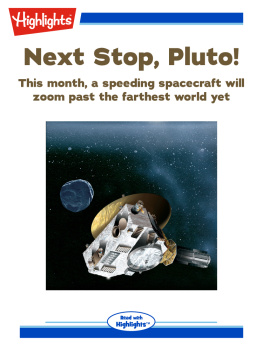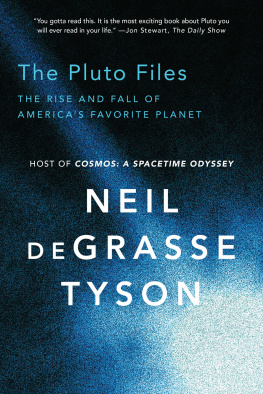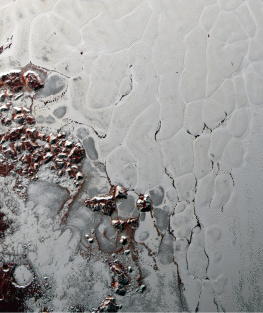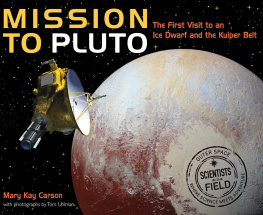Copyright 2015 by Richard Grossinger. All rights reserved. No portion of this book, except for brief review, may be reproduced, stored in a retrieval system, or transmitted in any form or by any meanselectronic, mechanical, photocopying, recording, or otherwisewithout the written permission of the publisher. For information contact North Atlantic Books.
Published by
North Atlantic Books
P.O. Box 12327
Berkeley, California 94712
Cover art by Aphelleon/Shutterstock.com
Cover design by Susan Quasha
Hades (pp. 27-32) from The Dream and the Underworld by James Hillman. Copyright 1979 by James Hillman.
Pluto: New Horizons for a Lost Horizon is sponsored and published by the Society for the Study of Native Arts and Sciences (dba North Atlantic Books), an educational nonprofit based in Berkeley, California, that collaborates with partners to develop cross-cultural perspectives, nurture holistic views of art, science, the humanities, and healing, and seed personal and global transformation by publishing work on the relationship of body, spirit, and nature.
North Atlantic Books publications are available through most bookstores. For further information, visit our website at www.northatlanticbooks.com or call 800-733-3000.
Library of Congress Cataloging-in-Publication Data
Pluto : New Horizons for a lost horizon : astronomy, astrology, mythology / edited by Richard Grossinger.
pages cm
Summary: An anthology about Pluto, encompassing astronomy, mythology, psychology, and astrology with original essays and excerpts of classic required reading about our most famous dwarf planetProvided by publisher.
ISBN 978-1-58394-897-2 (pbk.)ISBN 978-1-58394-898-9 (ebk.)
1. Pluto (Dwarf planet) 2. PlanetsExploration. 3. New Horizons (Spacecraft) I. Grossinger, Richard, 1944 editor.
QB701.P63 2014
523.4922dc23
2014039181
v3.1
Contents
Introduction
R ICHARD G ROSSINGER
T his anthology puts Pluto into scientific, cultural, and psychospiritual context in conjunction with NASAs New Horizons mission, the centerpiece of which is the transit of an Earth-originating satellite with the dwarf planet and its moons on July 1415, 2015. The dedicated capsule of instruments was launched atop an Atlas V rocket at 14:00 EST on January 19, 2006, from Pad 41 at Cape Canaveral Space Center in Florida after an eight-day delay, initially to allow last-minute testing of the rockets kerosene tank, then to avoid high winds and low cloud ceilings downrange.
It is compelling to picture local weather on Earth affecting the delivery of a package at cloud-less, wind-less Pluto more than nine years later.
A half hour after lift-off, the rockets Centaur second stage reignited the probe and sent it into a solar-escape speed and trajectory. New Horizons crashed lunar orbit in a mere nine hours and was out of the Moons gravitational field before midnight.
As the scientific package zips 6,200 miles above a bleak Plutonian landscapethe Sun a bright star in perpetual nightPluto becomes the last and farthest-flung member of the original nine-body Solar System to be imaged close-up through a transiting Homo-sapiens lens.
But the book (or digital display) that you hold in your hand is not just a program guide for an engineering feat; it is the pursuit of a mytheme, an irreducible kernel with at least three manifestations: a god, an astrological organizing principle, and a planet. Plutos mythology, astronomy, astrology, science fiction, and politics form a series of semiotic networks that have to do less with imaging a far-off frigid rock and more with staring into a mirror of our own cosmology in crisis.
Unmanned human assignation with a planet, though a mere mite floats above an orb hundreds of thousands of times its mass and size, is never innocent and without metaphysical consequences. Hours after Voyagers close encounter with Uranuss moon Miranda (January 28, 1986), the space shuttle Challenger exploded, driving NASA temporarily out of the heavens. Likewise when NASA put Galileo, a plutonium-238-driven satellite, on a 108,000-miles-per-hour suicidal plunge into Jupiters atmosphere (September 21, 2003), the collision sent a black nuclear cloud hurtling down through the planets cloud layers and changed everything about astrological Jupiter on Earth.
Borderline planet, gadfly, and changeling object, Pluto is Earths Planet X, a vortex of seeds from beyond space and time, a quixotic 1930s dark body bundling inconclusive physical and paraphysical equations, a mischievous intruder in the zodiac who redefines every chart by the fact that his passage along its threshold evokes the imperceptible shock wave of the system itself.
Pluto also crosses the destiny of the human enterprise at the moment that its own crisis transits with Plutoa synchronicity inside the zodiac, which is Synchronicity Central anyway. Why that played out in interbellum 1930 with precisely that elusive trans-Neptunian pellet, and again at hailing distance in 2015, is a cosmic mudra of an unknown sphinx. But NASA could no more not go after this meme in its last gasp at completing a solar circuit than it could avoid putting a man on the Moon or send robots scuttling across equally inscrutable Martian deserts in their time.
While perhaps little more than an escaped moon or common plutino exoterically, esoterically Pluto is an alchemical vas hermeticum, a vessel that, without revealing its nature, translates everything that comes into contact with it into its own icons and symbologies. Plutonian artifacts have a Mbius Strip quality (like a barbers pole of energy) such that their meanings oscillate, in a continuous way, from inside their vessel onto its surface. At Pluto, opposite qualities like joy and despair, utopia and apocalypse, grace and brutalityinside and outsidefuse or exchange properties, as they become momentarily indistinguishable. Much too far away to care, Pluto has bigger fish to fry.
I am reminded of words that transpersonal intelligence Seth invested in our plane via his medium Jane Roberts:
[T]his dimension [e.g., source realm] nurses your own world, reaching down into your system. These realities are still only those at the edge of the one in which you have your present existence. Far beyond are others, so alien to you that I could not explain them. Yet they are connected with your own life, and they find expression even within the smallest cells of your flesh.
Thats Pluto in spades, a deep-lying chimera across which Plutonian sigils project a reality too alien for Earthlings to glean, transmit it right down into their DNA as into the quantum states of their planets atoms, every particle of dust, grain of sand, and morsel of soil and stone. Even the ordinary Plutonian glob, more than 98 percent nitrogen ice, reinvents itself beyond disclosure of its actual identity or reference point. Science simply doesnt reach that deep into a higher-dimensional universe; it doesnt look far enough into the heavens to see Pluto as more than a pip of old Sol-orbiting rock (though of ambiguous enough caliber to be worth quibbling over). Of course, thats what it is in this dimension or at this astrophysical vibration, but who knows how many dimensions the starry field reflects as it twinkles from an incomprehensibly vaster sky.















